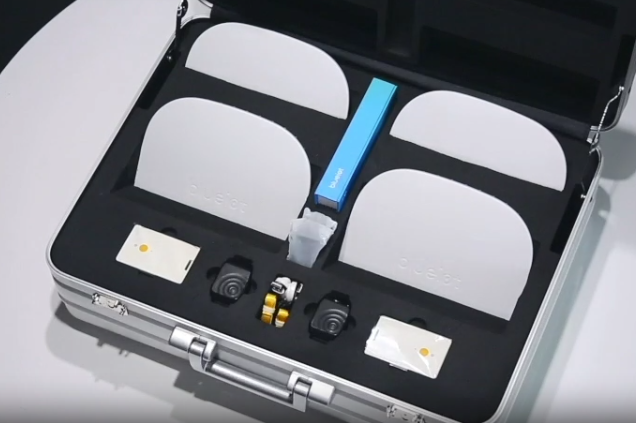At a time when wireless positioning technology is booming, the demand for indoor positioning is becoming increasingly prominent. Traditional positioning technologies such as RSSI (based on signal strength) positioning are difficult to meet the demand for high-precision positioning in complex scenarios due to their limited accuracy. Bluetooth AOA (angle of arrival) positioning technology has become a rising star in the field of indoor positioning with its centimeter-level to sub-meter-level positioning accuracy. As a core technology, angle of arrival tracking provides key support for the realization of high-precision positioning.

Principle and implementation of angle of arrival tracking
The application of angle of arrival tracking in Bluetooth AOA is based on the principle of phase difference measurement. Transmitting devices, such as smartphones or tags, use a single antenna to transmit signals. The receiving device is equipped with an antenna array consisting of multiple antennas. When the signal passes through the antenna array, due to the difference in distance between different antennas and the transmitting device, the path length of the signal to each antenna is different, resulting in a phase difference. The receiving device samples IQ data (in-phase and quadrature phase information) from the signal packet and analyzes the phase difference of the received signal of each antenna in the array. Based on the geometric layout of the antenna array and the signal frequency, an algorithm is used to convert the phase difference into the angle of arrival. For example, in a two-dimensional plane, if two receivers are at different radii, the phase difference of their received signals can be calculated through trigonometric function relationships to obtain the signal arrival angle.
In practical applications, arrival angle tracking requires multi-base station collaborative positioning. A single base station can only determine the direction line of the signal through the arrival angle information, and cannot directly locate the device position. Therefore, the system needs to deploy multiple Bluetooth AOA base stations and fuse the arrival angle data of multiple base stations through triangulation. The specific steps include: each base station independently measures the signal arrival angle; based on the known position and angle information of the base station, calculate the possible location intersection of the device; through multi-base station data fusion, eliminate the uncertainty of the intersection of the direction line and accurately determine the device location.
Advantages and challenges of arrival angle tracking
The application of arrival angle tracking in Bluetooth AOA has significant advantages. First, it achieves high-precision positioning from centimeter level to sub-meter level. Compared with the accuracy limitation of 3-5 meters of traditional Bluetooth RSSI positioning technology, the AOA introduced by the Bluetooth 5.1 protocol improves the accuracy to 0.3-0.5 meters, and even up to 10 centimeters in some scenarios. Secondly, the technology has low power consumption and high compatibility. As a standard technology for mobile phones, Bluetooth can support C-end applications without additional hardware, and the button battery life can be up to 10 years. In addition, deployment flexibility and low cost are also its important advantages. The antenna array design is simplified (for example, only two sets of antennas are needed for positioning), which greatly reduces the hardware deployment cost. At the same time, it also has high concurrent processing capabilities, supports large-scale tag simultaneous positioning, and is suitable for dense equipment management in industrial scenarios.
However, the application of angle of arrival tracking in Bluetooth AOA also faces some challenges. Signal reflection in dense building environments can cause angle measurement errors. Studies have shown that the positioning error in urban environments can reach 20 degrees, while in open areas it is only 1 degree. In addition, antenna switching time compensation and phase deviation correction are critical to accuracy. For example, Silicon Labs' EFR32BG22 chip reduces the angle error to within 5 degrees by integrating a switching time compensation module.
Actual application scenarios of angle of arrival tracking
The application scenarios of angle of arrival tracking in Bluetooth AOA are wide. In shopping malls, airports and other scenarios, consumers can obtain store navigation or product location guidance in real time through their mobile phones, with an accuracy of within 0.5 meters, significantly improving the user experience. In factories, personnel, equipment and materials can be tracked in real time through AOA tags to optimize production processes. Combined with the deployment of 5G base stations and smart light poles, this technology can cover signal blind spots such as underground parking lots and tunnels, and assist in autonomous driving parking and emergency evacuation. For example, the personnel positioning system of a chemical plant can monitor the distribution of personnel in dangerous areas in real time and improve the level of safety management. Hospitals use patient bracelets with AOA tags to track the location of patients, combine the electronic fence function to prevent high-risk patients from getting lost, and optimize the scheduling efficiency of nursing staff.
Future prospects of angle of arrival tracking
With the continuous advancement of technology, the application prospects of angle of arrival tracking in Bluetooth AOA will be broader. In the future, Bluetooth positioning technology will further improve positioning accuracy and stability, and overcome interference factors such as multipath effect and signal noise by optimizing key technologies such as antenna array design and signal processing algorithms to achieve more accurate positioning. At the same time, with the continuous advancement of hardware technology and the reduction of costs, the cost and power consumption of Bluetooth AOA positioning technology will be further reduced, making it more suitable for large-scale deployment and long-term operation. In addition, Bluetooth AOA positioning technology will be expanded to more application scenarios, such as autonomous driving, intelligent manufacturing and other fields, bringing more convenience and benefits to people's lives and work.
As the core technology of Bluetooth AOA, angle of arrival tracking provides key support for the realization of high-precision positioning. Despite some challenges, with the continuous advancement and improvement of technology, it will play an important role in more fields and promote the development and innovation of indoor positioning technology.